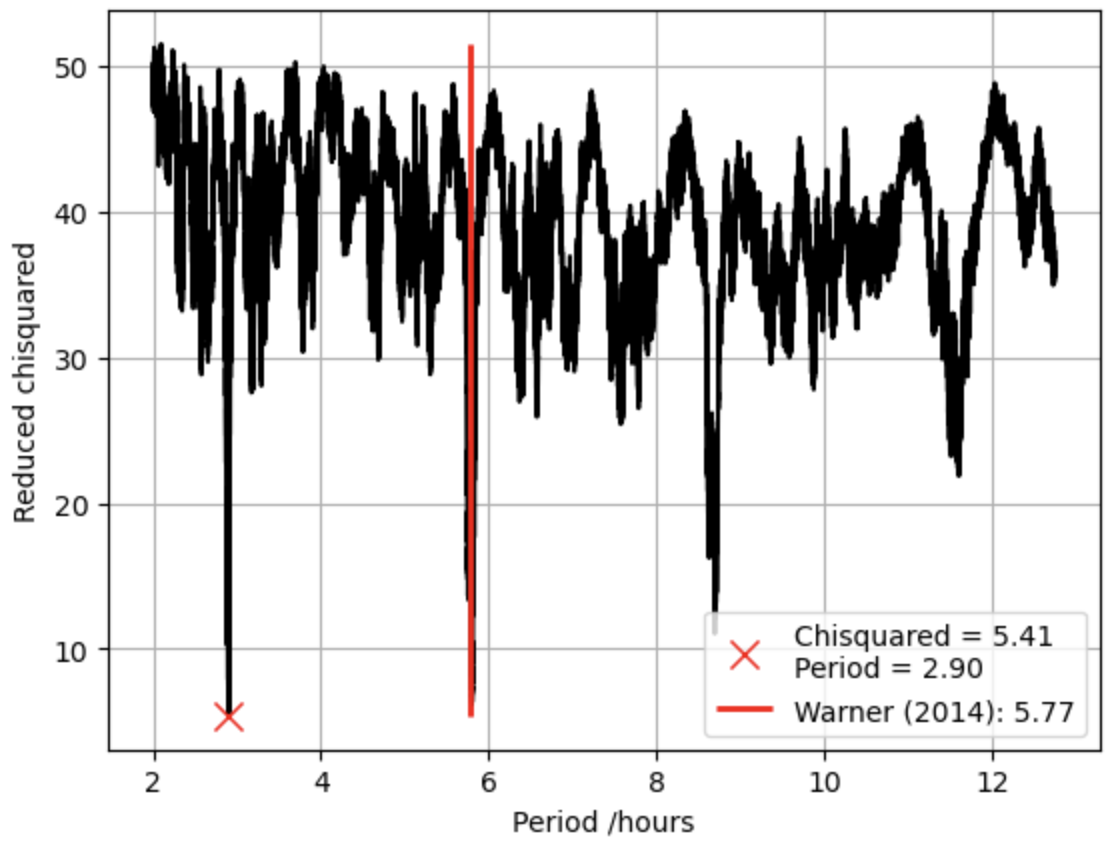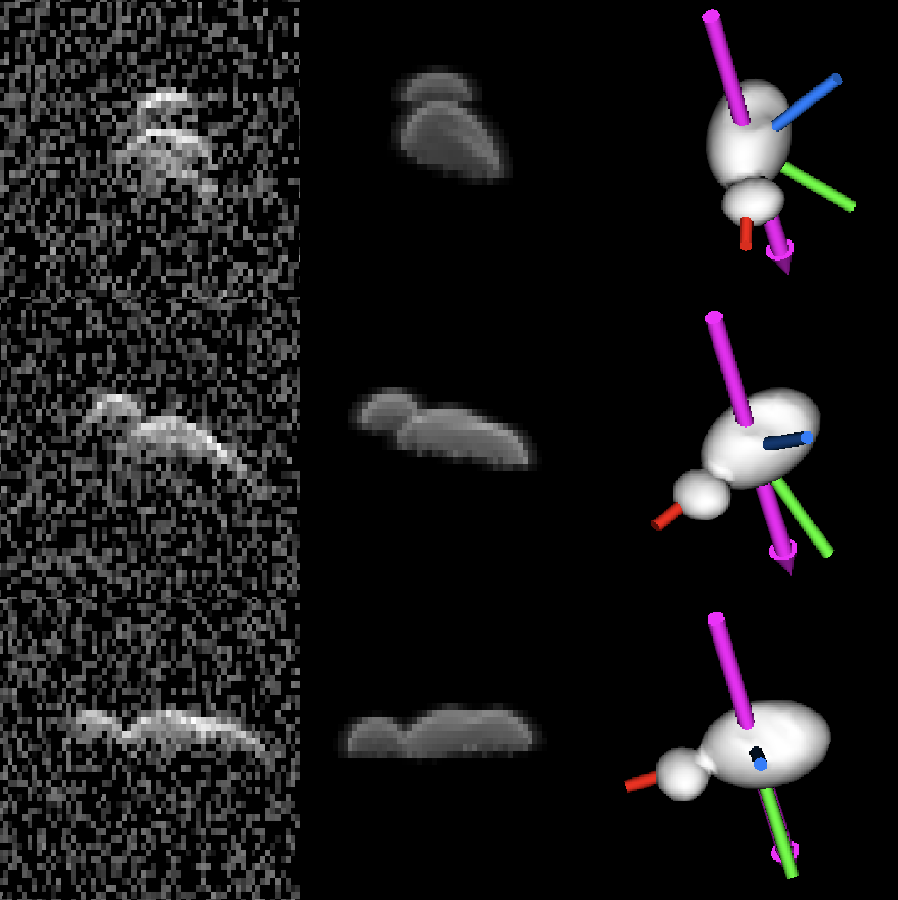Shape model of contact binary asteroid 2006 DP14 using radar and optical data
- 1Institute for Astronomy, University of Edinburgh, Royal Observatory, Edinburgh, EH9 3HJ, UK
- 2Jet Propulsion Laboratory, California Institute of Technology, Pasadena, CA 91109, USA
- 3Astronomical Institute of the Czech Academy of Sciences, Fričova 298, CZ-25165 Ondřejov, Czech Republic
Introduction
Bilobed objects (contact binaries) appear across the solar system in both asteroid and comet populations. Radar imaging reveals that at least 15% of near-Earth asteroids (NEAs) are contact binaries [1] but bilobed objects have also been detected in the Asteroid Belt and the Kuiper Belt. Notable examples include Itokawa (NEA), Selam (main-belt asteroid), and Arrokoth (trans-Neptunian object). It is currently unknown whether contact binaries form predominantly as two separate objects or are the natural evolution of a single body. Theories for contact binary formation in asteroids include the reaccumulation of fragments resulting from a catastrophic collision [2]. A second possibility is that the two lobes could be formed from a rotational instability as a result of YORP [3]. To date, the sample size of modelled contact binaries stands at thirteen, with only six from the NEA population. We present the model of Apollo group asteroid (388188) 2006 DP14 (henceforth DP14) which demonstrates a contact binary like structure in publicly available radar data from 2014 (Figure 2).
Observations
We collected optical photometry of DP14 during over two nights in 2014, one from a 0.36-m telescope at the Perth Observatory in Australia, and one from the PROMPT1 0.41-m telescope in Cerro Tololo, Chile. We have 9 nights of data from 2022, 5 of which are semi-sparse lightcurves obtained from the Danish 1.54-m telescope on La Silla, while the other 4 are complete lightcurves obtained from the 2.54-m Isaac Newton Telescope on La Palma, Spain. Finally, we have 3 nights of densely populated lightcurves from the Danish telescope from 2023. The INT and 2023 lightcurves were collected in the SDSS-R filter, reduced with standard procedures and calibrated to ATLAS REFCAT-2 stars in the field after PSF photometry. The 2022 data from the Danish telescope was calibrated in the Cousins R system with the Landolt standards with absolute accuracy of 0.01 mag. In our modelling, we also used published data spanning two nights in 2014, collected from a 0.6-m telescope at the CS3-Palmer Divide Station [4].
The radar data used was recorded in 2014 at the Goldstone DSN antenna in the United States and contains two nights of delay-Doppler images and 3 sets of echo power spectra.
Modelling
To model DP14 we first performed convex inversion [5,6] in order to refine the spin-state solution and generate a convex hull of the asteroid's shape. While these results were inconclusive for the rotational pole it allowed us to gain a good estimate of the period (see Figure 1), and allowed us to confirm the rotational pole was in the southern hemisphere when creating our initial conditions for further modelling with radar.

Figure 1: Periodogram of the convex inversion performed on all the lightcurves. It is known from radar imaging that the object is elongated, so although the best solution is a fit for a single-peaked lightcurve, we instead used the two-peaked solution that agreed with Warner (2014) [1] as initial conditions for the radar modelling.
We used the SHAPE modelling software [7] to combine the optical lightcurves with radar echo spectra and delay-Doppler images from 2014 from the Goldstone DSN antenna. We first used a simple single ellipsoid estimation of shape in order to refine the spin-state solution, before moving on to a bi-ellipsoid model. The inherent degeneracy of pole solutions in radar modelling resulted in minima at both the south and north pole but, given the results of the convex inversion and measurement of Yarkovsky effect (negative A2 in the most recent orbital solution) from optical and radar astrometry, we used the southern pole solution. We then switched to a vertex shape model fit in order to refine the shape and allow for better fitting to the narrow neck and the crater visible on the elongated body of the target seen in the delay-Doppler images.
As a preliminary result, we have determined that DP14 has a distinctive narrow neck connecting two lobes of unequal size. Results suggest a period of 5.77 ± 0.05 hours and a rotational pole of approximately β = -80 and λ = 50. The radar model can be seen in Figure 2.

Figure 2: Left column: Delay-Doppler images of DP14 taken with the Goldstone DSN antenna in the United States on 12/02/2014. The second image was taken approximately 50 minutes after the first, with the third another 30 minutes later. Centre column: The simulated delay-Doppler images created from the preliminary model. Right: The plane of sky views of the model with a pink axis representing the rotational pole.
Summary & Conclusion
We have reached a spin-state solution with a rotational pole close to the south pole of the ecliptic, as is observed in the majority of NEAs. Modelling reveals results expected from a visual inspection of the data, with an elongated body with a large crater on its side and smaller more spherical head connected by a narrow neck. The model of DP14 will allow better comparisons to theory based dynamical simulations to investigate its likely origins, while an additional spin-state solution and shape model give vital hints into not only the object's own formation history, but allow us to place the results in the wider context of other similarly shaped solar system objects.
Bibliography
[1] Benner, L. A. M. et al. In Asteroids IV ; University of Arizona Press: 2015, pp 165–182.
[2] Campo Bagatin, A. et al. Icarus 2020, 339, 113603.
[3] Jacobson, S. A. et al. Icarus 2016, 277, 381–394.
[4] Warner, B. D. Minor Planet Bulletin 2014, 41, 157–168
[5] Kaasalainen, M.; Torppa, J. Icarus 2001, 153, 24–36.
[6] Kaasalainen, M.; Torppa, J.; Muinonen, K. Icarus 2001, 153, 37–51.
[7] Magri, C. et al. Icarus 2007, 186, 152–177.
How to cite: Cannon, R., Rożek, A., Snodgrass, C., Brozović, M., Pravec, P., Holc, T., and Robinson, J.: Shape model of contact binary asteroid 2006 DP14 using radar and optical data, Europlanet Science Congress 2024, Berlin, Germany, 8–13 Sep 2024, EPSC2024-660, https://doi.org/10.5194/epsc2024-660, 2024.